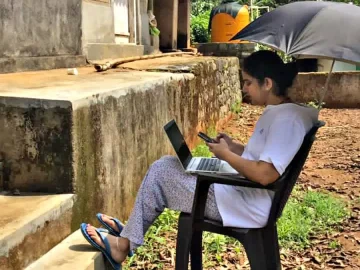Mandated furloughs for nursing home employees with mild COVID-19 symptoms may exacerbate existing staffing shortages and lead to worse resident health outcomes than allowing those employees to work while masked, a new study finds.
The research, however, is certain to draw controversy from some public health officials and long-term care leaders who question the wisdom of allowing employees with COVID to care for residents.
Investigators from the City University of New York Graduate School of Public Health and Health Policy conducted the simulation study of a 100-bed nursing home facility to measure the impact of furloughing staff with mild COVID on existing staffing shortages and the potential health impacts on residents unrelated to COVID. The study appeared Monday in JAMA Network Open.
Bruce Y. Lee, MD, MDA, a professor of health policy and management at the CUNY Graduate School of Public Health and Health Policy, said Centers for Disease Control and Prevention guidance says employees with symptoms of COVID should stay home, even with very mild symptoms. However, he said one of the unintended consequences of furloughing employees is that most nursing homes are already facing staffing shortages and sending more people home exacerbates those shortages, leading to gaps in patient care.
“If you don’t have enough people to do these tasks, there can be significant consequences,” Lee told McKnight’s Long-Term Care News Monday. “The trouble is, since there are already baseline staffing problems in nursing homes, sending people home will only worsen those staffing issues and that can result in even worse outcomes and deaths.”
Lee’s research team included investigators from Johns Hopkins and U-C Irvine. They used data from nursing homes in Orange County, CA, as well as previous studies, on the impact of understaffing on patient outcomes, and cost data from the Centers for Medicare & Medicaid Services to build their simulation model.
Researchers found that for a typical 100-bed nursing home facility, understaffing unrelated to COVID was associated with missed tasks, more resident hospitalizations and increased number of deaths, costing more than $1 million annually. Using their simulation model, they found that furloughing staff who test positive for SARS CoV-2 was associated with an annual average of 326.5 furlough days and 649.5 in missed care tasks, resulting in 4.3 non-COVID related resident hospitalizations and 0.7 deaths. The additional cost was $247,090 annually.
The study further found that allowing 75% of staff who were mildly ill to work while masked was projected to mitigate staffing shortages, resulting in additional care tasks being performed by employees and fewer non-COVID related hospitalizations and deaths — without significantly increasing COVID transmission.
“This modeling study found that mandatory furlough of nursing home staff with mild COVID-19 illness was associated with more resident harm from missed care tasks than with harm from increased COVID-19 transmission,” the authors wrote. “In the current climate of extreme nursing home understaffing, allowing those with mild COVID-19 illness to work may prevent more harm from staffing shortages and missed care tasks, ultimately saving substantial costs.”
Wisdom of findings questioned
Jodi Eyigor, director of Nursing Home Quality and Policy for LeadingAge, a national association representing nonprofit providers, acknowledged that sufficient staffing of nursing homes is a critical issue in the nursing home industry, but she questioned the wisdom of allowing staff with COVID symptoms to work.
“Resident well-being, which is part of that quality care, includes being kept safe from harm, including possible infection from highly contagious infectious diseases. It’s important to remember that this study’s findings are based on modeling, not real life, actual practices,” Eyigor said in an email to McKnight’s Long-Term Care News.
“We urge everyone to take all respiratory viruses seriously and to stay home when ill,” she added. “Allowing symptomatic individuals to work, particularly if they are still testing positive, is ill-advised, particularly in light of current Centers for Disease Control and Prevention guidelines, which nursing homes must follow.”
According to current CDC guidelines, healthcare workers with mild to moderate illness can return to work after at least seven days have passed since symptoms first appeared if a negative viral test is obtained within 48 hours prior to returning to work, if they haven’t had a fewer in the last 24 hours and if other symptoms have improved.
Denise Winzeler, RN, BSN, LNHA, DNS-MT, QCP-MT, of the American Association of Post-Acute Care Nursing, acknowledged that staffing challenges are at the forefront of everyone’s mind, as well as ways to overcome these challenges, but she added that allowing employees to work with COVID is problematic.
“If a facility allows their employees to work with mild COVID-19 symptoms due to staffing shortages, they must have a strong infection control program in place which follows not only their own facility policies, but also CDC and CMS recommendations,” she said in a statement to McKnight’s. “They should also have a process in place to ensure that employees follow the facility infection control program to mitigate the risk of transmission and maintain safety for everyone.”
Lee said the researchers are not suggesting employees with moderate or severe COVID be forced to work. He said they are only talking about those employees with mild or no COVID symptoms; those employees would be required to wear N-95 masks and take other precautions to avoid any further transmission of the disease to residents or other staff.
Lee said current CDC guidance about how long employees with mild COVID should remain out of work has been a bit vague and there also has been an issue of false positives with some COVID tests. He said he hopes the agency’s Healthcare Infection Control Practices Advisory Committee will consider some of the study’s findings when making future recommendations about infection control practices for employees with COVID.
“You always have to consider the unintended consequences of different policies,” he said. “Given the understaffing of nursing homes, there is an impact of COVID-19 furlough policies so that should be taken into account in deciding what to do on this issue.”




